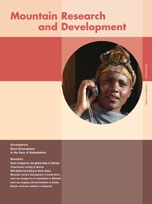BioOne.org will be down briefly for maintenance on 14 May 2025 between 18:00-22:00 Pacific Time US. We apologize for any inconvenience.
Focus Issue: Rural Development in the Face of Globalization
Editorial (1)
Development (6)
Research (7)
MountainPlatform (1)
MountainMedia (6)

No abstract available
No abstract available
No abstract available
No abstract available
No abstract available
No abstract available
No abstract available
No abstract available
